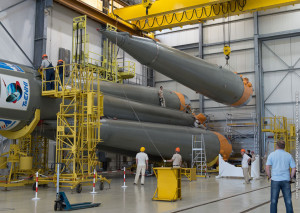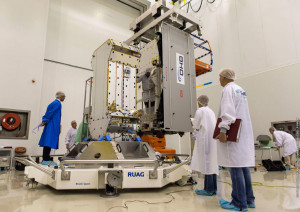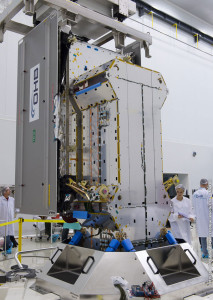The Soyuz launcher for Arianespace’s upcoming mission with the two Galileo satellites is taking shape at the Kourou Spaceport for a 27-March liftoff from French Guiana.
During activity in the Spaceport’s Soyuz Launcher Integration Building, the medium-lift workhorse began to assume its iconic form. The assembly of the Soyuz ST-B’s first two stages, plus its four first stage boosters, took place last week. Assembly takes place on a horizontal basis, in the Russian manner.
The next step will be the addition of Soyuz Block I third stage to the launcher’s core, then the main part of the launcher will be complete, ready to be transported to the Soyuz launch pad and moved to the vertical position, where the payload will be mated.
The final fourth stage of the Soyuz is the reignitable Fregat, which will transport the two satellites to their final 23 222 km altitude Medium Earth orbit. This will be attached to the Soyuz on the launch pad, once the satellites, their dispenser and launch fairing have been mounted on it.
The all-important ‘fit check’ was passed in the middle of February over a two-day period inside the Spaceport’s S1A payload preparation building. The two satellites were installed separately, with the Flight Model #3 (FM3) spacecraft integrated on, and subsequently removed from, the dispenser. Flight Model #4 (FM4) underwent the same process the following day. FM3 and FM4 were built by OHB System, with Surrey Satellite Technology Ltd. supplying their navigation payloads.
The payload dispenser was developed by RUAG Space Sweden, and has the task of holding (one satellite on each side) the satellites in place atop the Fregat during the launch and flight to their final orbit. It will deploy the spacecraft by firing a pyrotechnic separation system to release them in opposite directions at the orbital insertion point. They will be installed together later this month, after the satellites have been fuelled.
This 27-March mission, designated Flight VS11 in Arianespace’s numbering system, will be Arianespace’s fourth launch carrying spacecraft for the Galileo constellation. It will be the 11th Soyuz flight from French Guiana since the launcher’s introduction at the Spaceport in October 2011. Hence, it is designated Flight VS11 in Arianespace’s numbering system for its launcher family, which also includes the heavy-lift Ariane 5 and lightweight Vega.




